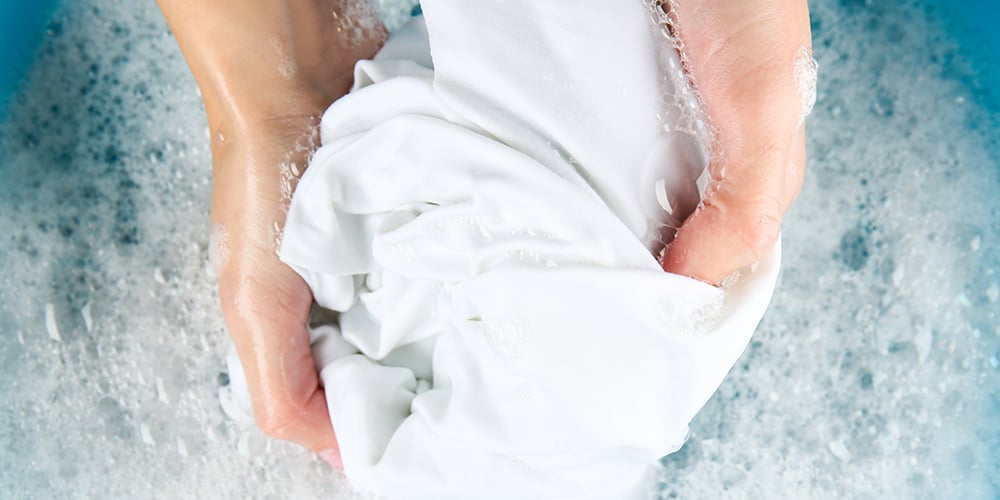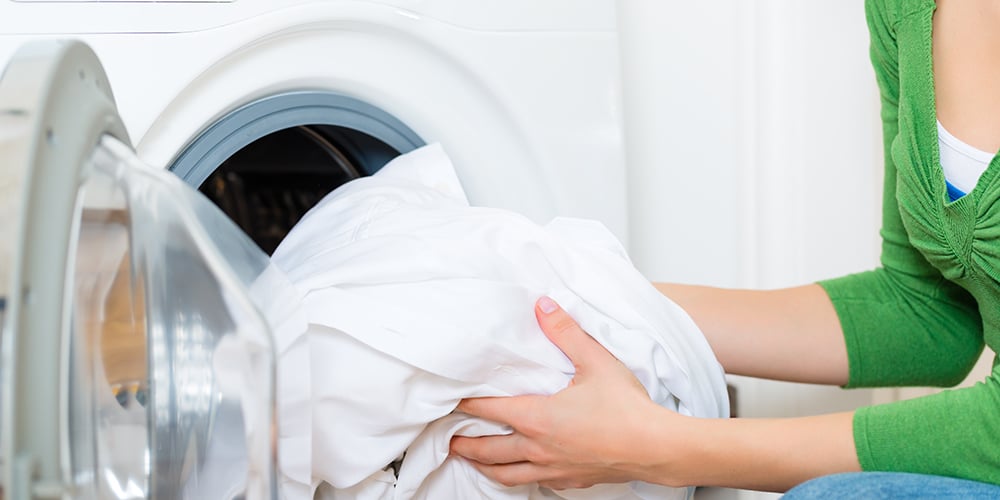Washing linens is a fairly straightforward process. However, how your linen is used will determine the method of care you choose.
Linen fabric is one of the most beloved textiles in the world. A smart choice for its contemporary look and durable quality, linen is used in products that range from upholstery fabric and drapery fabric to clothing and bedding.
Depending on how your fabric is applied, it can be machine washed, hand washed or dry cleaned. To maintain the quality of the fabric, it’s important to follow the cleaning recommendations for whichever method you choose in order to get the most out of your fabric.
Washing Methods
Before washing linen fabric, it is important to check the label for care instructions. Although fine linens may be washed using the different methods discussed below, the manufacturer may recommend a particular method for that piece.
Machine Wash
Smaller items like clothing or curtains can be washed in a machine. However, they should be separated based on color. Avoid washing light-colored fabrics with dark fabrics. Linen fabrics also should be washed in a separate load from other types of fabrics.
When using a household or commercial washing machine, keep the water temperatures no hotter than lukewarm, and preferably cold. Hot water may cause linen fabric to shrink or may weaken the fibers.
Additional tips include:
- Use the gentle cycle to keep the fibers intact.
- Do not overload your machine; this may prevent your fabric from getting evenly cleaned.
- Use mild (delicate) detergent, and do not bleach.
 Hand Wash
Hand Wash
If you choose to hand wash your linens, combine lukewarm water and approximately one teaspoon of mild detergent in a sink (or another container large enough to hold your fabric).
Soak your linen for about 10 minutes. Afterward, use your hands to gently move the fabric around in the container. Important note: DO NOT twist the fabric or scrub it, since this can damage the fibers in the fabric.
Allow the water to drain and refill the sink. Continue this step until all of the detergent is removed.
When linen is used for upholstery or pillows, hand washing will likely look different. It is important to check the manufacturer’s tag to see if there is a cleaning code or cleaning directions attached.
For example, the tag may include a “W,” which signals that the linen can be washed with water and a mild detergent solution. An “S,” on the other hand, requires cleaning with a solvent.
As mentioned above, do not use a water temperature any hotter than lukewarm, as this can damage the fibers.
Dry Cleaning
Linen is constructed using flax fibers. These natural fibers are more prone to wrinkling, which is where dry cleaning comes in handy.
Though washing your linens is perfectly acceptable, dry cleaning will save you the time associated with pressing the linens to remove any creases or wrinkles.
Drying Methods
 If linen is pre-washed, you can place linens in the dryer on low heat. This will help remove some wrinkles that are often associated with linen. However, you should remove the linens while they are still somewhat damp.
If linen is pre-washed, you can place linens in the dryer on low heat. This will help remove some wrinkles that are often associated with linen. However, you should remove the linens while they are still somewhat damp.
If the linen is used as upholstery on a piece of furniture or is on a larger piece that cannot be placed inside a dryer, air drying is required.
Pressing Methods
While you can also air dry your linens, you should be prepared to press them to remove any wrinkles.
To do this, turn your iron to its low to medium-hot setting and iron the linen fabric while it is still damp. You can also dampen a towel and place it over top the piece of linen before ironing.
Other Cleaning Techniques
Though bleaching can be used to brighten various fabrics, it is not recommended for linens. Bleaching can weaken the flax fibers. It also may discolor the fabric.
If your linen fabric is stained, it’s best to try to remove the stain as soon as possible. Soak the stain with a solution made of water and detergent. You can also spot clean the fabric with club soda, baking soda or even a small amount of white vinegar, followed by blotting the stain with a towel.
If spot cleaning doesn’t work, try first rubbing the stain with dish soap, removing any dirt possible. Then, wash the fabric either by hand or in a washing method using the tips outlined above.
Finally, regularly performing maintenance to your linens, especially in high-trafficked areas such as furniture or rugs, can help the fabric retain its fresh feel. A kitchen staple, baking soda, can be used to eliminate odors that build up by simply sprinkling some on the fabric, letting it sit and then removing the residue using a vacuum.
Bottom Line
Linen is one of the purest and most beautiful textiles used across the world. Though classic in design and dependable in use, linen requires some level of regular maintenance and cleaning in order to maintain its freshness.
Keeping linens clean so that they retain the fresh ambiance of a room is fairly clear cut, making linen one of the most durable and easy-to-care-for fabrics available.







Goodmorning Mr Nelson
I want to personally thank you .Because gotten an in depth description of how to
use your tips of ho to professionally care for
delicate beautiful intricate fabric..
Thank you!